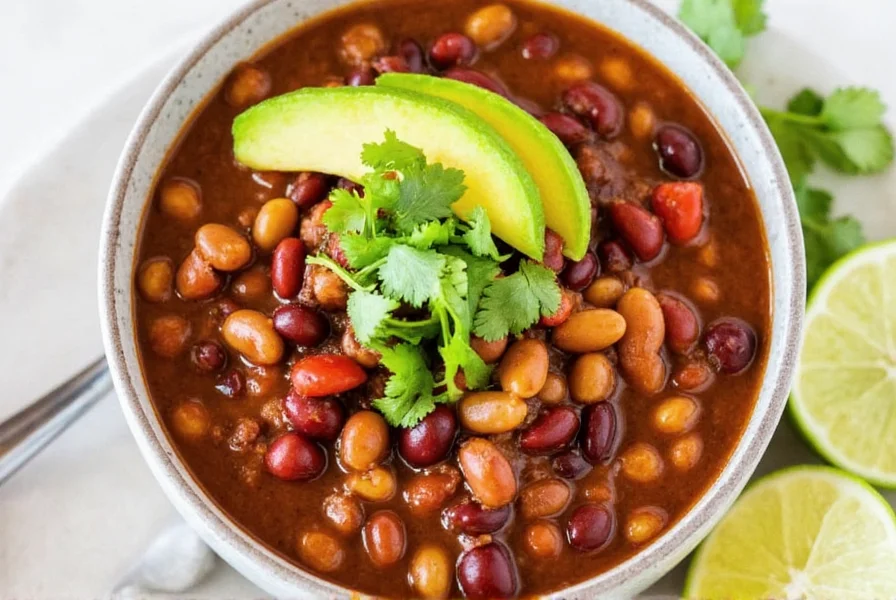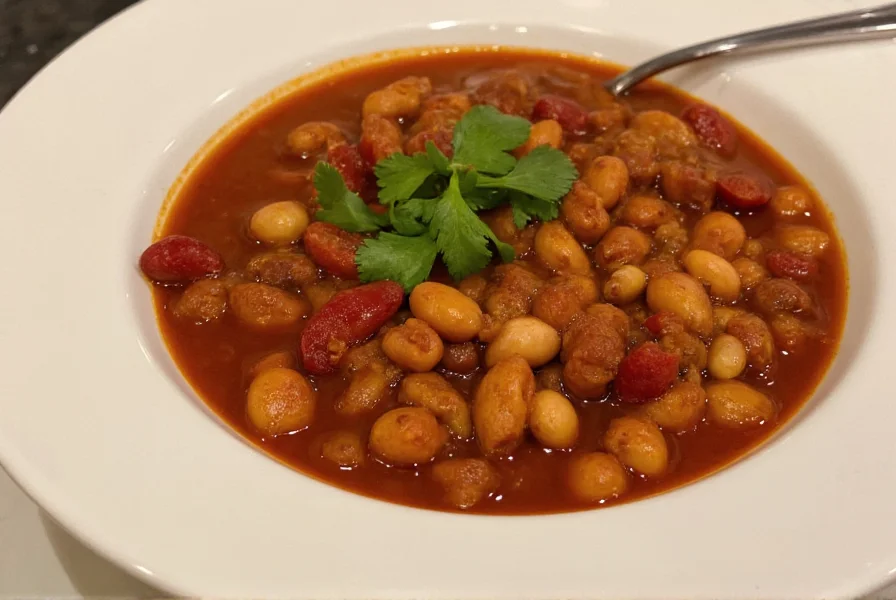Three bean chili represents one of America's most adaptable comfort foods, transforming traditional meat-based recipes into satisfying vegetarian options without sacrificing depth of flavor. Unlike conventional chili recipes that rely on ground beef, this version harnesses the complementary textures and nutritional profiles of three distinct beans to create a complex, satisfying dish that appeals to both vegetarians and meat-eaters alike. The magic happens when kidney beans provide meaty substance, black beans contribute earthy notes, and pinto beans melt into the broth to naturally thicken the mixture.
The Essential Three Bean Chili Recipe
Creating authentic three bean chili requires attention to bean selection and spice balance. Many home cooks make the mistake of using canned beans without proper preparation, resulting in watery texture and muted flavors. For optimal results, follow these professional techniques that elevate your three bean chili from ordinary to exceptional.

Ingredients for Perfect Three Bean Chili
| Ingredient | Quantity | Professional Tip |
|---|---|---|
| Dried kidney beans | 1 cup (soaked overnight) | Soaking reduces cooking time by 30% and improves digestibility |
| Dried black beans | 1 cup (soaked overnight) | Add 1 teaspoon baking soda to soaking water for creamier texture |
| Dried pinto beans | 1 cup (soaked overnight) | Don't skip soaking—canned beans create watery chili |
| Fire-roasted tomatoes | 28 oz can | Provides natural sweetness that balances spice |
| Chipotle peppers in adobo | 2 peppers + 1 tbsp sauce | Key for authentic smoky depth without liquid smoke |
Step-by-Step Cooking Instructions
- Prepare beans properly: Drain soaked beans and cover with fresh water. Bring to boil, then reduce to simmer for 45 minutes until partially tender but not fully cooked
- Build flavor foundation: In separate pan, sauté onions, garlic, and bell peppers until caramelized. Add spices (2 tbsp chili powder, 1 tsp cumin, 1 tsp smoked paprika) and toast for 1 minute
- Combine elements: Add partially cooked beans to vegetable mixture with tomatoes, chipotle peppers, and 4 cups vegetable broth. Simmer covered for 45-60 minutes
- Final thickening: Remove lid and simmer 15-20 minutes to concentrate flavors. Stir occasionally to prevent sticking
- Rest before serving: Let chili rest off heat for 15 minutes—this allows flavors to meld and texture to improve
Three Bean Chili Variations Worth Trying
While the classic three bean chili recipe satisfies most palates, these professional variations address specific dietary needs and flavor preferences. Understanding these adaptations makes your easy three bean chili recipe suitable for nearly any occasion.
Slow Cooker Three Bean Chili
For hands-off preparation, combine all ingredients in a 6-quart slow cooker after partially cooking beans. Cook on low for 6-8 hours. The extended cooking time allows pinto beans to fully break down, creating an exceptionally thick texture without additional thickeners. This crockpot three bean chili method produces deeper flavor development than stovetop versions.
Instant Pot Three Bean Chili
When time matters, use your pressure cooker to make three bean chili in under 45 minutes total. Skip the soaking step—add dry beans directly with other ingredients. Cook at high pressure for 25 minutes, then allow natural release for 15 minutes. The high-pressure environment perfectly cooks all three beans to identical tenderness, solving the common problem of uneven bean texture.
Professional Tips for Exceptional Three Bean Chili
Achieving restaurant-quality three bean chili at home requires understanding these often-overlooked techniques:
- Acid balance: Add 1-2 tablespoons of apple cider vinegar during the last 10 minutes of cooking. This brightens flavors and makes the healthy three bean chili taste more complex
- Bean layering: Add kidney beans first (they hold shape best), pinto beans midway, and black beans at the end for optimal texture in your vegetarian three bean chili
- Thickening without starch: Mash 1/2 cup of cooked beans and stir back into the pot—this creates perfect consistency without flour or cornstarch
- Flavor development: Refrigerate overnight—three bean chili always tastes better the second day as flavors fully integrate

Nutritional Benefits of Three Bean Chili
This meatless chili delivers impressive nutritional value per serving (1.5 cups):
- 22g plant-based protein—comparable to meat-based chili
- 15g dietary fiber—more than half your daily requirement
- Low glycemic index—ideal for blood sugar management
- Naturally gluten-free and easily made vegan
- Rich in iron, magnesium, and folate from the diverse bean varieties
The combination of three different beans creates a complete protein profile while providing varied textures that keep each bite interesting. Unlike single-bean recipes, the best three bean chili recipe leverages how each bean contributes unique nutritional benefits and mouthfeel.
Serving Suggestions for Maximum Enjoyment
Elevate your three bean chili experience with these chef-recommended pairings:
- Top with fresh avocado slices and lime juice to enhance nutrient absorption
- Pair with cornbread made with stone-ground cornmeal for authentic Southwestern experience
- Offer dairy-free cashew cream as topping for creamy texture without dairy
- Include pickled red onions for brightness that cuts through the richness
- Accompany with a simple green salad featuring radishes and cilantro dressing
Frequently Asked Questions
Can I use canned beans instead of dried for three bean chili?
Yes, but with important adjustments. Drain and rinse three 15-ounce cans of each bean variety. Add them during the last 30 minutes of cooking to prevent mushiness. For better flavor, simmer canned beans in vegetable broth for 10 minutes before adding other ingredients. The cooking time for canned bean three bean chili reduces to 45 minutes total, but the texture won't be as robust as when using dried beans.
How do I make three bean chili thicker without altering flavor?
The professional technique involves creating a 'bean paste'—remove 1-2 cups of chili (with some beans and liquid), blend until smooth, then return to the pot. This thickens naturally while enhancing bean flavor. Alternatively, uncover and simmer for 15-20 minutes to reduce liquid. Avoid flour or cornstarch which can create pasty texture in authentic three bean chili recipes.
What's the best way to store and reheat three bean chili?
Store cooled chili in airtight containers for up to 5 days in the refrigerator or 3 months frozen. For optimal texture when reheating, add 1-2 tablespoons of water or broth per cup of chili and warm gently over medium-low heat, stirring occasionally. Never boil reheated chili as this breaks down bean structure. The best three bean chili always tastes better the second day as flavors continue developing during storage.
Can I make three bean chili spicy without overwhelming heat?
Achieve balanced heat by using multiple chili sources: 1 teaspoon ancho chili powder (fruity depth), 1/2 teaspoon cayenne (direct heat), and 1 diced jalapeño (fresh brightness). Add spices early for integrated heat rather than late for sharp burn. For authentic three bean chili with adjustable heat, serve with hot sauce on the side. Remember that heat intensifies over time, so mild three bean chili today may become medium-spicy tomorrow.











 浙公网安备
33010002000092号
浙公网安备
33010002000092号 浙B2-20120091-4
浙B2-20120091-4